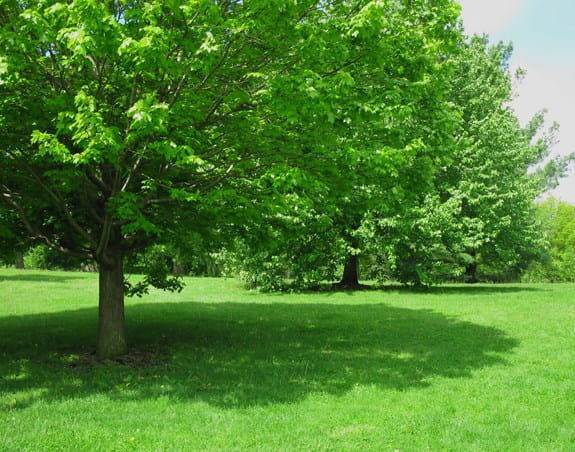Spotlight on sun safety
Make your own shade at home
Build your own shade

Adding a retractable awning or canopy to the side of your house is also an easy way to add shade. This allows you to adjust the protection you want depending on the sun’s location. The colour and thickness of the awning material is important to consider. Thick, tightly woven material in dark colours provides the most effective protection. Awnings can be used year-round, but many are easily removed and stored away during the winter.
Installing a porch roof or backyard patio roof offers more permanent sun protection. Remember to check the sun’s path around your home before building it to make sure the structure will provide effective shade coverage.
Plant your own shade

Planting deciduous trees like maple, birch, oak and beech that are native to Canada will provide excellent sun protection during the summer months. Be sure to select types of trees that provide large thick coverings of leaves that will block UV rays. For year-round protection, consider planting coniferous trees like hemlock, pine, spruce and cedar. But remember, these types of trees do not have natural canopies that provide midday shade, like deciduous trees do.
Think about how you use your space to decide which types of trees will grow best and provide you with the shade you need. When planting trees, think about:
- the way the sun moves around your home – remember UV rays are strongest between 11 a.m. and 3 p.m.
- the time you spend on the deck or patio
- the location of the swimming pool, sandbox or play area
Sunglasses are not just a fashion accessory – they protect your eyes from damage by blocking UV rays. This is important for kids too! Look for the kind that have both UVA and UVB protection. The label might say UV 400 or 100% UV protection.
Look for clothing that’s specially made to protect you from UV rays. The label shows the UV protection factor (UPF). UPF measures a fabric’s ability to block UV rays from passing through and reaching the skin. The fabrics are classified into categories based on their UPF.
Like a sunscreen’s SPF, the higher the UPF, the less UV radiation reaches the skin and the better the protection. The fabrics used for this clothing are often lightweight, and some may be treated with ingredients to help them block UV rays. Look for UPF 15 or higher. UPF 50+ blocks most UV rays.
Use an SPF of 30 or higher
Look for broad spectrum and water-resistant on the label
Apply a generous amount
Use sunscreen on any skin that clothing doesn't cover
Put sunscreen on first, before any makeup or insect repellent
Don't spray aerosol or pump sunscreen products directly onto your face
If you forget to put it on before going outside, it's not too late
Reapply sunscreen at least every 2 hours
Use a lip balm with SPF and reapply when needed
Apply sunscreen on cloudy days and during the winter months
Try different sunscreens until you find the one you like
Take care with products that combine sunscreen with makeup or moisturizer
Check the expiry date
Does sunscreen cause cancer?
Sunscreen has chemicals that help protect your skin from harmful UV rays. Currently, there is no evidence that using sunscreen increases your risk of cancer. We need more research to understand how much these chemicals are absorbed into the body and the effects they might have over time.
Sunscreens are designed to protect you from direct sun exposure when you can’t avoid it – they’re not meant to be used to extend your time in the sun. Spending a lot of time in the sun, not putting on enough sunscreen or not reapplying sunscreen often enough all increase your risk of skin cancer.
It’s important to use sunscreen along with shade, clothing and hats, not instead of them. Doing all of these things together lowers your risk of getting skin cancer.
What about studies that suggest people who use sunscreen have a higher risk of developing skin cancer?
Scientists don’t think this increased risk is caused by any chemical – it comes from the fact that people who use sunscreen spend more time in the sun than people who don’t use sunscreen. And many of these people may not be applying sunscreen properly.
Being safe in the sun is still the best way to reduce your risk of developing skin cancer. Protect yourself when the sun is at its strongest, cover your skin with clothing, wear a hat and sunglasses and use a sunscreen with an SPF 30 or higher.
If I stay out of the sun, how do I get enough vitamin D?
Vitamin D is needed for healthy bones and muscles, especially in children and older adults. Your body makes vitamin D when your skin is exposed to sunlight.
The amount of sun exposure needed to produce enough vitamin D depends on:
- age
- diet
- skin colour
- where you live
- how strong the sun is
For most people, just a few minutes out in the sun – the short, casual exposure you get while going about daily life – will be enough. You don’t need to intentionally expose yourself to the sun or visit tanning beds to get adequate vitamin D.

How else can I get vitamin D?
Your trusted source for accurate cancer information
With support from readers like you, we can continue to provide the highest quality cancer information for over 100 types of cancer.
We’re here to ensure easy access to accurate cancer information for you and the millions of people who visit this website every year. But we can’t do it alone.
Every donation helps fund reliable cancer information, compassionate support services and the most promising research. Please give today because every contribution counts. Thank you.

